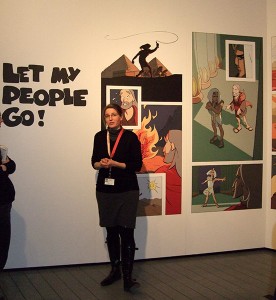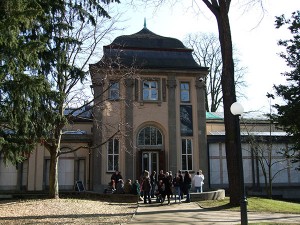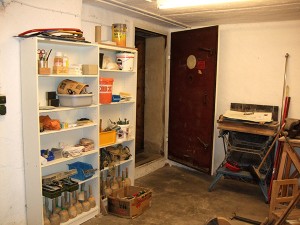This year, the national museum assistant convention of the German Museums Association took place from March 1 to 3 in Frankfurt-am-Main, and the theme was “Museum today: ideals, trends, and perspectives.” The convention offered academic trainees from federal German museums and memorials an extensive array of lectures, excursions, and workshops. Along with all the other museum assistants, I was impressed by the diversity of events. The Historical Museum served as a set starting point, having put nearly its entire premises at the disposal of the convention.

Sabine Kößling in front of the remodeled mural at the Jewish Museum Frankfurt
© photo: Michaela Roßberg, Jewish Museum Berlin
On the day of our arrival, there was already a chance to take a tour through one of the many museums on the embankment of the Main. I visited the Jewish Museum Frankfurt, where our group was guided by Sabine Kößling, a former museum assistant at the Jewish Museum Berlin. She told us about the planned conception of the permanent exhibition, which originates largely from 1988, the year that the museum was founded. The reworking of the exhibition is being done in stages, so that the entire museum won’t need to be closed to visitors until 2014. The section on “Festivals and feast days – religious life”, for example, was being augmented with a large mural depicting the story of Moses and the Pharaoh.
The second day featured a number of workshops. I participated first in one called “Provenance research is power: arm yourself.” Maike Brüggen, provenance researcher at the Historical Museum in Frankfurt, and Jasmin Hartmann, trainee at the Bureau for Provenance Investigation & Research in Berlin, explained the political, moral, and personal dimensions of restitution proceedings, the Washington Conference Principles, as well as the work of their institutions. Several sensational cases from recent years served as examples, for instance the return of Berlin Street Scene by Ernst Ludwig Kirchner and the events surrounding the Portrait of Wally by Egon Schiele. Most of those present learned for the first time that it is possible to apply for research and investigation funding when an object’s origins are unclear or in doubt.

Entrance to the Liebieghaus on the Museum Embankment in Frankfurt
© photo: Michaela Roßberg, Jewish Museum Berlin
That afternoon, I attended a talk at the Liebieghaus on the subject of “Creating inventories in museums.” Lisa Mach and Yvonne Adam of the Open-Air Museum Hessenpark discussed their approach to inventory systems and introduced guidelines for dealing with and describing objects. There were numerous questions from the audience, including inquiries about their criteria for rejecting objects offered to the museum. Mach and Adam spoke not only about the problem of incongruity with the museum’s concept for the collection but also about reasons for rejection like lack of space or of appropriate storage facilities. Very few trainees were familiar with the data banks or collection strategies of their museums. Quite a number of those institutions still exclusively maintain card catalogs. In particular, the smaller museums, those with a long history and often a very large collection, reach the limits of their resources in exactly this endeavor: compiling adequate records of their holdings.
On Sunday morning, I attended “Perspectives,” which was a sort of marketplace that introduced museum assistants to professionals for perspectives on their future. Unfortunately there were only two exhibition departments and one custodian present, in addition to a lawyer, since trainees always have a host of questions about their contracts and rights. The Museum Association’s recommendations with respect to engaging museum assistants very often diverge greatly from reality. Thus, over 70% don’t even have a plan for their further education, with around 20% needing additional employment because of the low pay at the museum, and a majority of 54% having to receive support from their parents.

Entrance to the archives of the German Leather Museum Offenbach
© photo: Michaela Roßberg, Jewish Museum Berlin
After an official farewell with acknowledgements, we had an opportunity to visit various museums in the area. I chose the German Leather Museum Offenbach, because the tour was to be led by the provenance researcher Beatrix Piezonka along with the museum’s leather restorer, Jutta Göpfrich, and would provide their specialized perspective on the permanent exhibition. With funds from the Institute for Provenance Research, Piezonka devotes herself to the task of examining museum correspondence from the years 1933 to 1944, which is stored in the museum’s basement. Göpfrich and her employees have to grapple above all with the perishability of leather. This extraordinarily interesting excursion provided a fitting end to an exciting weekend.
Michaela Roßberg, Museum Assistant